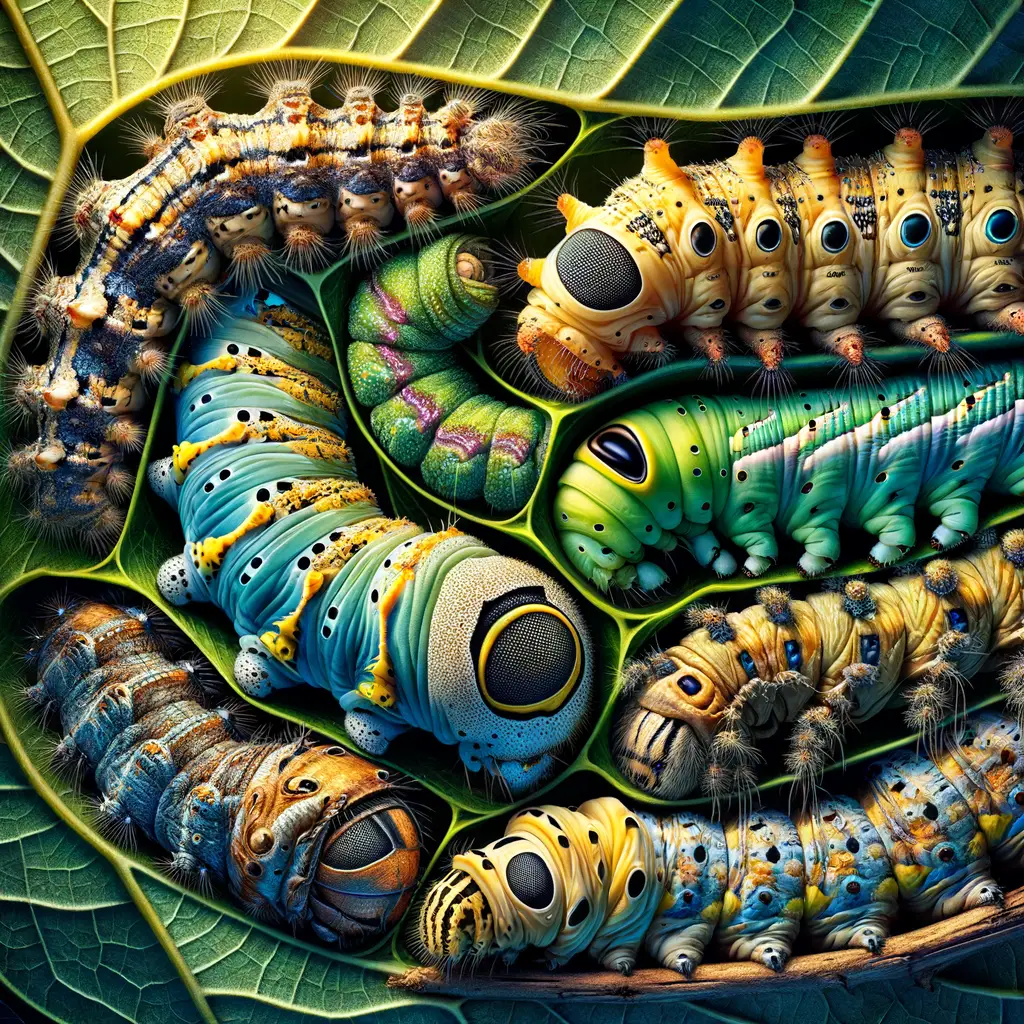
Introduction to Caterpillar Camouflage Techniques
Camouflage is a survival technique used by many creatures in the animal kingdom, and caterpillars are no exception. This introductory section will provide an overview of caterpillar camouflage and explain why it is so essential for their survival.
- Overview of Caterpillar Camouflage
- Importance of Camouflage in Caterpillar Survival
Caterpillars, the larval stage of butterflies and moths, employ a variety of camouflage techniques to blend into their surroundings. These techniques range from mimicking the color and texture of leaves to adopting the appearance of less appetizing or dangerous creatures. Some caterpillars even go as far as to mimic the physical characteristics of their environment, such as twigs or bird droppings, to avoid detection by predators.
Camouflage is a vital survival strategy for caterpillars. As they are slow-moving and often targeted by a variety of predators, including birds, reptiles, and other insects, blending into their environment is often their best defense. By mimicking the colors and patterns of their surroundings, caterpillars can effectively hide in plain sight, reducing the risk of predation and increasing their chances of reaching adulthood and reproducing. According to a study, caterpillars that use camouflage have a significantly higher survival rate than those that do not.
In the following sections, we will delve deeper into the fascinating world of caterpillar camouflage, exploring specific case studies and examining the different types of camouflaging caterpillars. So, stay tuned to learn more about these masters of insect disguise.
Masters of Insect Disguise: Caterpillars
Among the fascinating world of insects, caterpillars stand out as masters of disguise. Their survival largely depends on their ability to blend into their environment, making them virtually invisible to predators. This is achieved through a variety of camouflage strategies.
Understanding Insect Camouflage Strategies
Camouflage is a survival strategy used by many insects, especially caterpillars. It involves a combination of various adaptations that allow these creatures to blend in with their surroundings. Let’s delve into the primary strategies caterpillars use to disguise themselves.
- Coloration
- Shape and Size
- Behavioral Adaptations
Caterpillars use coloration as a primary method of camouflage. They can match the color of their surroundings, making it difficult for predators to spot them. For instance, the Peppered Moth Caterpillar is known to change its color based on the tree it inhabits, effectively blending into the bark.
Another strategy caterpillars use is altering their shape and size. Some caterpillars, like the Geometridae, mimic twigs or leaves, making them nearly indistinguishable from their environment. Others can inflate parts of their bodies to appear larger and more intimidating to predators.
Behavioral adaptations also play a crucial role in caterpillar camouflage. Some caterpillars remain motionless during the day when predators are most active and only move around at night. Others, like the Death’s-head Hawkmoth caterpillar, mimic the behavior of dangerous species to deter predators.
In conclusion, caterpillars are truly the masters of insect disguise. Their ability to adapt their coloration, shape, size, and behavior to their environment is a testament to the incredible diversity and adaptability of life on our planet.
Camouflaging Caterpillars: Case Studies
Let’s delve into the fascinating world of caterpillar camouflage by examining two intriguing case studies. These examples will demonstrate how these tiny creatures use their environment to their advantage, blending in seamlessly to avoid predators.
- Case Study 1: The Peppered Moth Caterpillar
- Case Study 2: The Swallowtail Caterpillar
The Peppered Moth Caterpillar is a master of disguise. This species, scientifically known as Biston betularia, is native to Europe and North America. It has a unique ability to change its color based on the environment it lives in. This phenomenon is known as industrial melanism.
During the Industrial Revolution, when soot covered trees, the Peppered Moth Caterpillar turned black to blend in. As the environment cleaned up, they reverted back to their original light color. This adaptation helped them survive in changing environments, showcasing the incredible adaptability of these creatures.

The Swallowtail Caterpillar, or Papilio machaon, is another fascinating example of caterpillar camouflage. This species is found across North America, Asia, and Europe. The Swallowtail Caterpillar uses a different tactic – it mimics the appearance of bird droppings to deter predators.
By adopting this unappetizing disguise, the Swallowtail Caterpillar successfully deters potential predators, ensuring its survival. This is a perfect example of how caterpillars use their environment and even the behaviors of other species to their advantage.

These case studies highlight the remarkable survival tactics of caterpillars. Their ability to blend into their surroundings is a testament to the wonders of nature and evolution. Stay tuned for more fascinating insights into the world of insects.
Insect Camouflage Masters: Caterpillar Survival Tactics
In the world of insects, survival is a game of hide and seek. Among these tiny creatures, caterpillars are the masters of disguise. They use a variety of tactics to blend into their surroundings, making them nearly invisible to predators. Let’s explore some of these fascinating survival strategies.
Camouflage in Nature: Caterpillar Adaptations
Caterpillars have evolved a range of adaptations to help them stay hidden. These include adaptive coloration, mimicry, and counter shading. Each of these tactics plays a crucial role in their survival.
- Adaptive Coloration
- Mimicry
- Counter Shading
Adaptive coloration is a common tactic used by caterpillars. This involves changing their color to match their environment. For example, a caterpillar living on a green leaf will often be green itself, making it hard for predators to spot. This is a perfect example of how caterpillars use their surroundings to their advantage.
Mimicry is another clever tactic used by caterpillars. Some species can make themselves look like other, more dangerous animals. For instance, the Spicebush Swallowtail caterpillar can make itself look like a small snake, scaring away potential predators. This is a remarkable example of how caterpillars use deception to survive.
Counter shading is a form of camouflage where the caterpillar’s top side is darker than its underside. This makes it hard for predators to see the caterpillar from above or below. The caterpillar appears flat, rather than three-dimensional, making it blend in with its surroundings even more.
These survival tactics are not just fascinating to observe, but they also highlight the incredible adaptability of caterpillars. Their ability to blend into their environment is a testament to the power of evolution and the relentless struggle for survival in the natural world.
Caterpillar Defense Mechanisms: Beyond Camouflage
While many of us are familiar with the incredible camouflage abilities of caterpillars, these fascinating creatures have a variety of other defense mechanisms that they use to protect themselves from predators. Let’s explore some of these strategies beyond their well-known camouflage techniques.
-
Chemical Defenses
Caterpillars are not just masters of disguise, but they also have a unique chemical defense system. Some species of caterpillars produce toxic chemicals in their bodies, which they can release when threatened. These toxins can cause irritation, nausea, or even paralysis in their predators. A classic example is the Monarch caterpillar, which feeds on milkweed plants and absorbs their toxins, making them poisonous to predators. Learn more about Monarch caterpillars here.
-
Physical Defenses
Physical defense is another effective strategy employed by caterpillars. Some caterpillars have spiky bodies or sharp bristles that can deter or harm predators. For instance, the Buck Moth caterpillar has sharp, venomous spines that can cause painful reactions in predators and humans alike. Discover more about Buck Moth caterpillars here.
-
Behavioral Defenses
Behavioral defenses are also a crucial part of a caterpillar’s survival strategy. Some caterpillars will play dead, while others will thrash or drop off their perch to escape predators. Certain species even mimic the behavior of dangerous animals to scare off threats. For example, the Eastern Tiger Swallowtail caterpillar can inflate a part of its body to resemble a snake’s head when threatened. Find out more about Eastern Tiger Swallowtail caterpillars here.
In conclusion, caterpillars are not just masters of camouflage, but they also employ a range of other defense mechanisms to ensure their survival. From chemical and physical defenses to clever behavioral strategies, these fascinating creatures are truly adept at protecting themselves in the wild.
Types of Camouflaging Caterpillars
In the vast world of insects, caterpillars are known for their remarkable ability to blend into their surroundings. This is a survival tactic that helps them avoid predators. There are several types of camouflaging caterpillars, each employing unique techniques to stay hidden. Let’s explore some of these fascinating creatures and their camouflage strategies.
Exploring the Diversity of Camouflaging Techniques
Camouflaging techniques among caterpillars are as diverse as the species themselves. These techniques can be broadly categorized into leaf mimicry, bark mimicry, and stick mimicry. Each of these techniques is a testament to the caterpillar’s adaptability and the intricate designs of nature.
- Leaf Mimicry
- Bark Mimicry
- Stick Mimicry
Leaf mimicking caterpillars are a marvel of nature. They have evolved to resemble leaves, complete with veins and leaf-like patterns on their bodies. This allows them to blend seamlessly into the foliage, making them nearly invisible to predators. An example of this is the Geometridae family of caterpillars, which are known for their leaf-like appearance.
Bark mimicking caterpillars use their coloration and patterns to blend into tree bark. Some even have body structures that mimic the texture of bark, making them nearly indistinguishable from their surroundings. The Peppered Moth Caterpillar is a well-known example of this type of camouflage.
Stick mimicking caterpillars are masters of disguise. They have elongated, slender bodies that resemble twigs or branches. By staying still, they can fool predators into thinking they are just another part of the tree. The Geometrid caterpillars are a prime example of this camouflage technique.
These camouflaging techniques are just a glimpse into the fascinating world of caterpillars. By understanding these techniques, we can appreciate the complexity and beauty of nature and its creatures.
Conclusion: The Art of Camouflage in the Insect World
As we conclude our exploration of the fascinating world of insect camouflage, it’s clear that these tiny creatures are true masters of disguise. They utilize a range of strategies, from color matching to mimicry, to blend into their surroundings and evade predators. Let’s summarize our key takeaways and look at the future directions of research in this field.
- Key Takeaways
- Future Research Directions
Our journey through the world of insect camouflage has revealed some truly astounding facts. We’ve learned that caterpillars, in particular, are experts in the art of disguise, using a variety of techniques to blend into their surroundings. From the Peppered Moth that changes its color to match the bark of trees, to the Orchid Mantis that resembles a beautiful flower to attract its prey, the insect world is full of incredible examples of camouflage.
While we’ve learned a great deal about insect camouflage, there’s still much to discover. Future research will likely delve deeper into the genetic and environmental factors that influence these camouflage techniques. Scientists are also interested in how climate change and habitat destruction might impact these survival strategies. The lessons we learn from these tiny creatures could have big implications, not just for conservation efforts, but also for our understanding of evolution and adaptation.
As we continue to explore and learn from the insect world, we can only marvel at the intricate and ingenious ways these creatures have adapted to their environments. Their mastery of camouflage is a testament to the incredible diversity and resilience of life on our planet.
